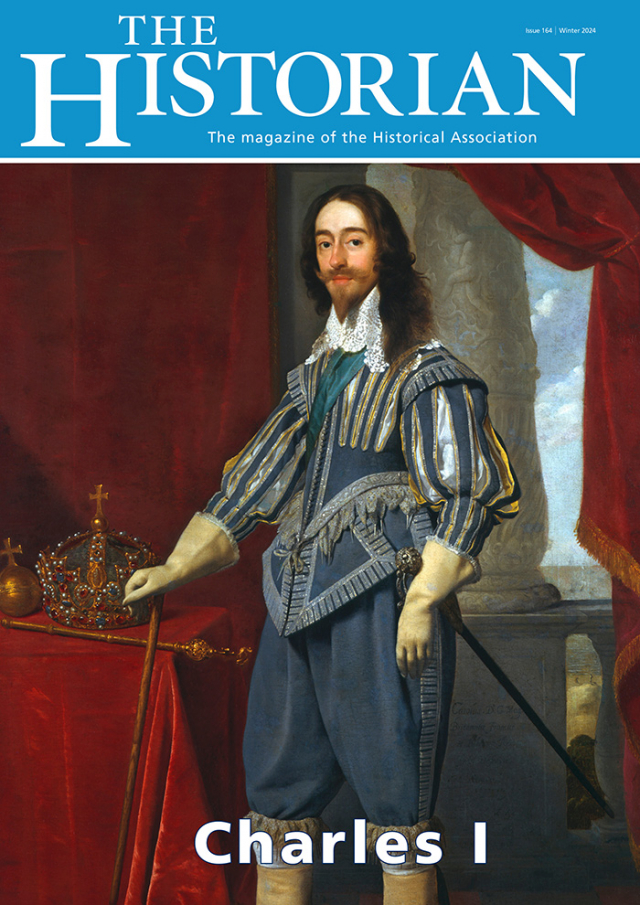The Historian 165: Out now
The magazine of the Historical Association

Editorial: Charles I
Read The Historian 165: Charles I
25 March 2025 marked the 400th anniversary of Charles I’s accession to power in England, Ireland, Scotland and Wales. Following a devastating civil war and less than twenty-five years after his accession, Charles was executed. This issue of The Historian reflects on the Caroline period, moving attention away from Charles’ demise and subsequent reputation to address, instead, political and cultural aspects of his reign.
In an overview of historical debates centred upon Charles’ reign, Michael Questier demonstrates how the King’s legacy remains as controversial as ever. He looks at two diametrically opposed contemporary accounts of monarchical authority in the Stuart period to see what they might tell us about the direction of future research. Taking us through revisionist and post-revisionist accounts of Charles’ reign, he argues for a more nuanced understanding of the King, as a conscious participant in the shaping of his cultural legacy and realpolitik approaches to domestic and international policy.
As Charles’ reign ended in civil war and the execution of the King, his government has often been dismissed as a disaster. Charles faced considerable problems, some of which were a hangover from earlier monarchs, which made his reign especially challenging. Charlotte Brownhill, however, argues that there are some positive features of Charles’ kingship, not least his personal dedication to government. This article unpacks some of the features of government during Charles’ reign, arguing that particularly in the 1620s and 1630s, the Caroline government had some successes.
Religion sat at the heart of day-to-day life in Caroline Britain and Ireland. Chris R. Langley reflects on the complexity of the Stuart inheritance with its multiple different religious traditions. For example, while both England and Scotland were Protestant countries and had been since the sixteenth century, the religious journeys of both kingdoms were profoundly different. When faced with attempts to reform liturgy and theology, however, a decision made by Charles and his advisor William Laud, Archbishop of Canterbury, had knock-on effects in all the other territories. Nowhere was this more apparent than in Charles’ approach to religious reform in Scotland.
A neglected topic of study is the women who served Queen Henrietta Maria from her marriage in 1625 until her death in 1669. Sara J. Wolfson’s article reveals how Caroline court women played an active role in household service, court family networks, religious politics, and seeking financial and political patronage. Yet female court service did not end for elite women with the outbreak of civil war in 1642. Instead, this article draws attention to Henrietta Maria’s female household in England and overseas, highlighting how elite women operated beyond the confines of national politics and geographical boundaries on behalf of themselves and their families.
Chris R. Langley explores the richness of primary sources available to historians of mid-seventeenth century Britain and Ireland, considering some of the different types of documentary evidence that have been used by historians. To help shine light on different aspects of the period, we asked colleagues at several of Britain’s leading heritage sites and archives to tell us which item in their collection reveals most about Charles’ reign. Jessica Evershed, Outreach and Learning Archivist at the National Records of Scotland, discusses the National Covenant of 1638, a key document relating to the King’s downfall. Mike Webb, Curator of Early Modern Archives and Manuscripts at the Bodleian Library, explores what the chronicle of Thomas Wyatt, Rector of Ducklington in Oxfordshire, tells us about local and national events during the Civil War period. Denise Greany, Glyn Hughes and Kevin Winter from the National Civil War Centre examine what the Newark siege pieces can tell us about the merging of civilian and military life during warfare. Finally, Alden Gregory, Curator of Historic Buildings for Historic Royal Palaces, considers how the Banqueting House became one of the defining monuments of Charles’ reign. Collectively, we hope that this special issue charts new ways of thinking about the Caroline period and Charles’ kingship.
Our other features reveal the effect of history on the present. Miguel Elias Escobar considers the colonial and contemporary history of Panama’s infrastructure, Kate Brooks reflects on the personal resonances of family history, and Young Historian competition winner Christopher Barnett analyses the decline and possible resurgence of trams in West Yorkshire. John Davis takes us on a history trail around Lyme Regis and Lynne Dixon showcases the architectural talents of Annabel Dott, while Sarah Pettyfer explains the uses of Manorial Court Records in Doing History. James Sewry interviews our own Tom Hamilton about his latest book, and our reviews cover everything from a history of money to the Tudors on screen. We hope that there will be something for everyone, and as always we welcome your comments and questions.

